Wood On Plastics: Automotive Rebounds Nicely
The trend is clearly rising, as we're projecting a gain of 15-18% from last year's rock bottom lows.
After seven straight years of decreases, the number of motor vehicles assembled in the U.S. finally increased in 2010. According to statistics compiled and reported by the Federal Reserve Board, 7.7 million motor vehicles were assembled here last year, a jump of 35% from the 5.7 million units assembled during the Great Recession of 2009. Our forecast is for this uptrend to continue throughout 2011, though the rate of growth will be less robust. We expect assemblies to rise to around 9 million units this year, a gain of 15% to 18%.
There may still be some pessimists among us who point out that two years of double-digit growth in auto assemblies is all well and good, but still not enough to get the industry back to pre-recession levels. And that is true, as the industry routinely cranked out 12 million units during the second half of the 1990s and the first half of the 2000s.
But the trend is clearly rising, and more importantly, the industry is making money. The last year the motor-vehicle and parts industry posted any real profits was 1998, and the amount they made in those days pales in comparison with the losses they suffered during the next 11 years. The early estimates suggest that the profits total was a tidy $8 billion to $10 billion in 2010.
While the short-term prognosis is quite good, there are still some dark clouds over the distant horizon. One problem with which the automobile industry is just starting to contend is the rising price of materials. Voracious global demand is pushing the prices of plastics, steel, and most non-ferrous metals up at an alarming rate. This could hurt many plastics processors in the near-term.
Recent hikes in the price of many resins—especially PP—have been painful, and the end-market demand is still tenuous enough that it is difficult to pass these increases on by raising the price of plastics parts. But over the long-term, the sharp increases in the price of steel and other metals will be a boon to plastics processors as lighter-weight, more cost-efficient, and more technically advanced plastics parts continue to replace metals in motor vehicles.
But as we have learned from some very painful lessons, the key to making money in the auto sector is anticipating changes in future consumer trends. Most of the buzz in recent months has centered on products that are “green” and “sustainable.” Autos that are smaller, lightweight, more fuel-efficient, maybe even all-electric, are touted as the future.
So it is something of a surprise to see that demand for U.S.-made light trucks (pick-up trucks, SUVs, and mini-vans) remains stronger than the market for domestically produced autos. A closer look at the Fed data shows that assemblies of light trucks fell by almost 30% in 2009 from the previous year, but rebounded by more than 40% in 2010. In all, there were about 5 million light trucks produced in America last year. By comparison, car assemblies fell a sharper 40% in 2009, and the recovery in 2010 was a less-vigorous 25%. There were fewer than 3 million cars assembled in this country last year.
As I write this, the average price of a gallon of gas is well north of $3, and is sure to go higher. So smaller, greener, all-electric cars may prove to be the best bet for domestic auto manufacturers. But the recent data suggest that consumers have yet to be convinced.
WHAT IT MEANS TO YOU
•Costs of materials, fuel, food, and medical care are all rising. Employment levels and wages are not. The directions of these trends in 2011 will increasingly affect the market for autos.
•Infrastructure projects such as the construction and repair of roads and bridges and train tracks will receive increased media attention in the coming years. But federal, state, and local governments are broke. These conflicts and their resolutions will impact the market for autos in coming years.
•While rising resin costs are hurting processors in the short term, plastics in the long term will continue to be the material of choice as the industry continues to move toward lighter vehicles.
Related Content
Neste, Borealis and Covestro Plan to Make Polycarbonate From Recycled Tires
Companies announced agreement that will use advanced recycling to convert old tires into new PC-suitable for automotive applications.
Read MorePlastic Compounding Market to Outpace Metal & Alloy Market Growth
Study shows the plastic compounding process is being used to boost electrical properties and UV resistance while custom compounding is increasingly being used to achieve high-performance in plastic-based goods.
Read MoreImpacts of Auto’s Switch to Sustainability
Of all the trends you can see at NPE2024, this one is BIG. Not only is the auto industry transitioning to electrification but there are concerted efforts to modify the materials used, especially polymers, for interior applications.
Read MoreHonda Now Exploring UBQ’s Biobased Material Made from Unsorted Household Waste
UBQ is aiming to expand its reach for more sustainable automotive parts as well as non-automotive applications.
Read MoreRead Next
Lead the Conversation, Change the Conversation
Coverage of single-use plastics can be both misleading and demoralizing. Here are 10 tips for changing the perception of the plastics industry at your company and in your community.
Read MoreMaking the Circular Economy a Reality
Driven by brand owner demands and new worldwide legislation, the entire supply chain is working toward the shift to circularity, with some evidence the circular economy has already begun.
Read MoreBeyond Prototypes: 8 Ways the Plastics Industry Is Using 3D Printing
Plastics processors are finding applications for 3D printing around the plant and across the supply chain. Here are 8 examples to look for at NPE2024.
Read More











